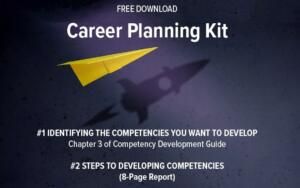Our intention is not to burst your bubble about your professional future, but let’s be honest: Your potential to be promoted to other roles within your organization has most likely already been evaluated by your employer, based on the skills, competencies, knowledge and those ‘wish list’ attributes you are perceived to possess.
But just how accurate is your employer’s perception of your capabilities? And what if the skills required for the role you wish to obtain were competencies you haven’t been given the opportunity to demonstrate yet? Is there even a way for you to know what is contained in this proverbial wish list?
Evaluating the skills and knowledge you’ve already acquired and used in your current role is one thing, but it’s those intangibles on your employer’s ‘dream candidate’ wish list that truly make the difference in terms of assessing your potential for career mobility.
When organizations use customized competency models, it provides you – and all employees – the consistency and objectivity you need to understand not only your performance and potential, but also what it takes to move up. Think of these models as road maps to your professional success, charting your course towards the progression you seek in your career.
Core skills are not enough
If you’re looking for career mobility, it’s not enough to simply possess and master the core technical skills required by your current job role. What makes you most attractive and valuable to your organization is a combination of, yes, these core skills, but also personal and intangible competencies. These intangibles are what sets you apart and what makes you shine in the eye of your employer.
But intangibles are, by definition, things that are not concrete. More specifically, they can be explained as things you can grasp the meaning of, but can’t wrap your hands around. So how can you know what is expected of you and, better yet, how can you develop competencies that are typically so subjective?
In comparing candidates’ performance and potential, a competency model provides a consistent, objective and valid framework for the evaluation of your skills. If none exists, you cannot really know what is being used as a measuring stick, e.g. loyalty to boss, tenure, etc. A model allows your employer to give you clearer, more concise and understandable feedback about your strengths and development opportunities. For instance, would you prefer to hear “you need to work on your selling skills” or “you would be more effective in selling your ideas if you more actively sought to understand others’ needs and concerns before trying to promote your ideas”? The latter is a lot more specific and helpful to you.
A competency model therefore helps you build your own development plan by pointing to specific behaviors that you master and those that you should improve. That’s the true value of a competency model for you.
Half the battle to your aspirations
When your company hired you, they were most likely evaluating you against a holistic group of qualifications: core, personal and potential intangible skills. Really, half the battle to achieving your career aspirations has already been won – you’re hired!
Now, as your workplace and industry evolve, you are expected to continue to learn and develop new skills, to adapt to change and take ownership over your professional growth. A well-executed competency model approach can help provide this… and we can help!
To learn more, visit our webpage here and don’t hesitate to share this article with your employer!
 To learn more about our products and services, and how competencies and competency models can help your organization, call 800-870-9490, email edward.cripe@workitect.com
To learn more about our products and services, and how competencies and competency models can help your organization, call 800-870-9490, email edward.cripe@workitect.com
or use the contact form at Workitect.
©️2024, Workitect, Inc.


Leave A Comment